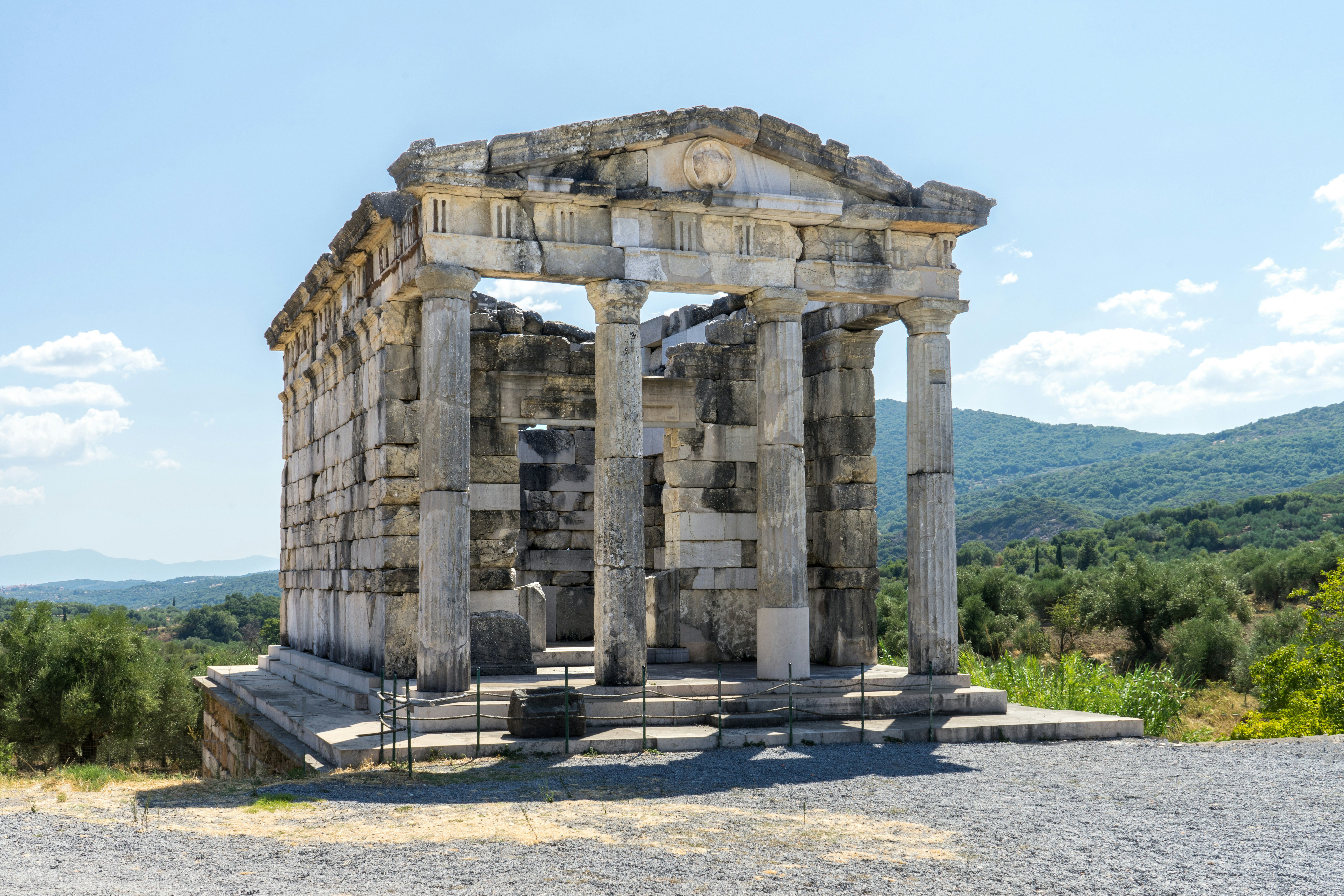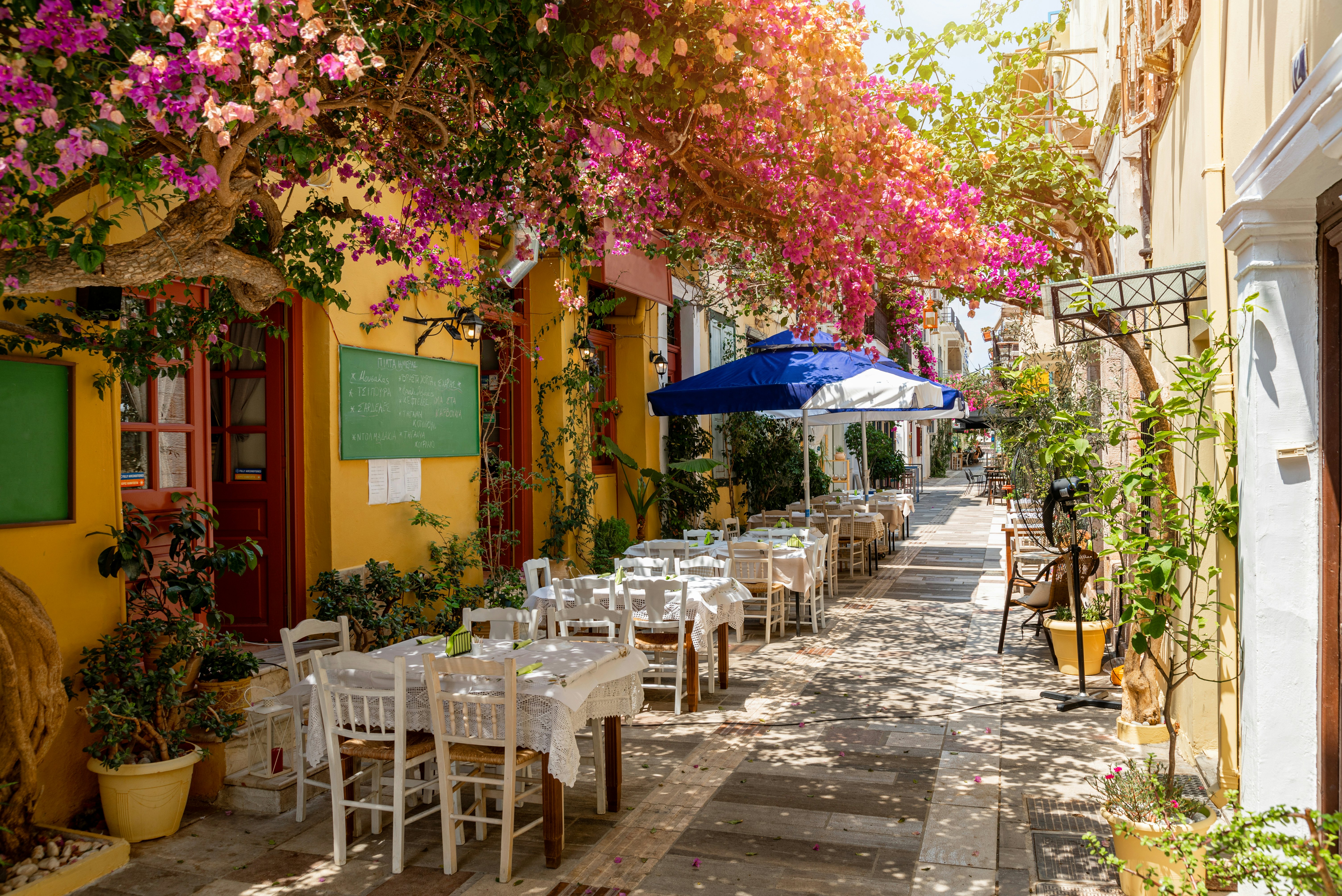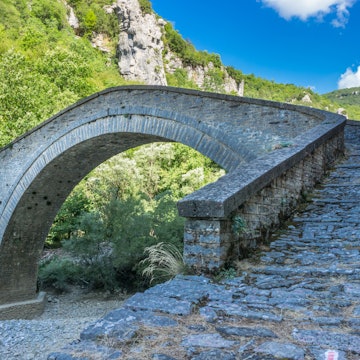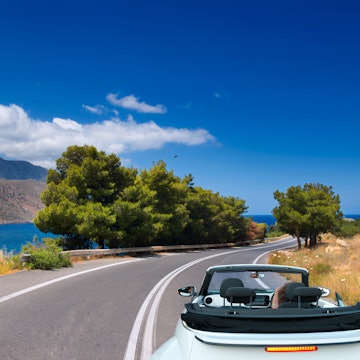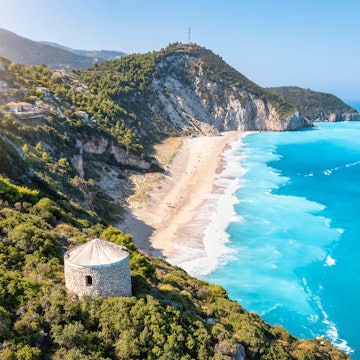

The ruins of Olympia; the birth place of Olympic games in Katakolon. Littleaom/Shutterstock
Many first timers to Greece, enticed by the beaches and sun dash to a Greek island or two. But for authentic Greek culture, the Peloponnese, the mainland region that hangs like an upside down hand, is legendary. (And, if you are seeking myths, many a Greek God was “born” here, too.)
For the traveler, the region’s valleys of olive and citrus groves, forested mountains and coastal stretches rival any isle. In any case – as locals joke – given the region is divided by the Corinth Canal, it could almost be an “island”. Within its borders, the Peloponnese also offers exquisite archaeological sites, some of Greece’s finest hiking trails, superb regional cuisine and the heartiest of Greek filoxenia (hospitality).
When should I go to the Peloponnese?
Any time! Like most of Greece, the region is busiest in high season (June to August) when visitors head to the coast. November and December sees holidaying locals enjoy the mountains, especially around Kalavryta. The rest of the year, thanks to the permanent population that lives here, much of the region operates year-round, especially the main towns of Nafplio, Patras, Ancient Olympia and Kalamata. Spring and fall are perfect for wildflowers and mountain hiking. In winter, tourist villages such as Monemvasia tend to be open for business on weekends.
How much time should I spend in the Peloponnese?
This is one of the trickiest questions to nail. One month gives you a chance to explore all the sub-regions of the Peloponnese: mountain hiking in Arkadia, beach fun around the coast, cultural exploits in Messinia and a sojourn through the spectacular, if remote, Mani. Three weeks will give you a good sense of the area, plus some archaeological visits.
In two weeks you can head to a few prime spots, such as Nafplio, Stemnitsa (and the surrounding Arkadian mountain villages), then south to Monemvasia or Kalamata and Kardamyli. Alternatively, from Stemnitsa, head west over the spectacular mountains and to Olympia (for Ancient Olympia). You can return via the northern coast; time your visit to take the Odontotos train from Diakofto to Kalavryta (see below: “My favorite thing to do”). One week gives you a satisfying taster – head to Nafplio and Monemvasia (or inland to the mountain villages and over to Olympia) and back via the northern road.
Is it easy to get in and around the Peloponnese?
Athens International Airport Eleftherios Venizelos is 103 miles (165km) northeast of the Corinth Canal, the border to the Peloponnese, and has many car hire outlets. Alternatively, a handy public KTEL bus service connects Leoforou Kifisou (Kifissos Bus Station) in Athens and Nafplio. To reach the bus station from the airport, take a regular bus X93 or the metro. To get around the Peloponnese, KTEL buses service most main towns and some villages, though some services are limited; for remote trips to the mountainous interior, it’s easiest to hire a car.
Ancient Mycenae. Collection Maykova/Shutterstock
Top things to do in the Peloponnese
Dive into Greece’s myths and archaeological past
Nowhere in Greece is crammed with as many unearthed archaeological sites as the Peloponnese. After all, it was in this region that many a Greek god and human hero strutted their stuff in historical sites, classical temples, Mycenaean palaces, Byzantine cities and Venetian fortresses. Nafplio is a good base to access several of these, including: Ancient Mycenae, home to King Agamemnon: Ancient Nemea, venue for the Nemean Games (the stadium here is fabulous); and the late-4th-century-BC Theatre of Epidavros, known for its outdoor acoustics.
In the region’s west is Ancient Olympia, birthplace of the modern Olympic Games. Further south of here, Ancient Messini is a 4th-century city (although the site existed for centuries) that’s enveloped by forested mountains and olive groves. Near Sparta is Mystras, a remarkable Byzantine town whose ruins cling to a hillside. In the region’s southeast, don’t miss the medieval rock fortress of Monemvasia. If its magic lures you to spend a night here, consider one of the boutique accommodations such as Hotel Byzantino (which is within the fortress or ‘rock’ itself); or, across the causeway, the cheaper, but spotless, option Hotel Filoxenia.
Amble through Nafplio, the original capital of Greece
Nafplio, declared Greece’s first capital after its independence in 1823 (before Athens got the honors), is one of Greece’s prettiest towns. Drop your bags at Hotel Marianna, a friendly, family-run hotel. It’s hard to pull yourself away from the hotel terrace where there’s no better view of Nafplio: neoclassical homes with Venetian shutters, terracotta roofs, and Ottoman minarets that reflect the town’s former on-and-off rulers over many centuries.
Visit the three forts: Akronafplia (by foot), Palamidi Fortress (clamber up the 900 or so of steep stairs!) and the Bourtzi (accessible by boat). Grab a drink at one of the several bars that line the bustling Syntagma Square, also the site of the interesting Archaeological Museum.
Hungry? Amble through the bougainvillea-covered alleyways and take your pick of boutiques and Greek taverns (it’s hard to go wrong). Just beyond the old town, Pidalio, is an excellent choice for its quality meze (share plates) and main dishes.
Explore mountain villages of Arkadia
The mountains of Arkadia are a world away from all things ocean; this forested locale is the hangout of legendary Pan, the half-God (man), half-goat, plus nymphs and dryads. Make your way along the winding country roads to Stemnitsa (around 62 miles (100km) west of Nafplio; watch out for goat herds) where you can watch village life from the pretty main square. The place to stay here is the delightful Mpelleiko run by local Nena, who whips up home-made omelets and breakfast treats in her lovely refurbished 16th-century home. Nena will direct you to all the best walks, including the Lousios Gorge walk, a gorgeous day walk through a ravine; you can visit ancient monasteries that cling to the cliffs.
You can explore the surrounding mountain villages of Dimitsana and Andritsena, as well as the extraordinary preserved Roman temple, Vasses of Apollo. For fine cuisine of the local variety (think fresh, seasonal produce sourced from local suppliers), do not miss Zerzova. It’s a half hour drive northwest of Stemnitsa and you can while away an afternoon on lamb, hilopites (local handmade noodles) and myzithra (the local cheese) dishes.
Tantalize your tastebuds on food tours
Home to the Kalamata olive variety, Kalamata is a great setting for food tours. The city’s surrounds – the region of Messinia – also produces excellent honey and other local delicacies. To get your teeth into foodie culture past and present, enjoy a half-day guided walking tour with Kalamata Food Tours. Local guide, Sofie, shows you the market and numerous traditional stores (cake shops, smoked meat specialists, honey spots) that you might otherwise miss. And of course, the tastings are highlights.
Fourteen miles (22km) northwest of Kalamata in the village of Androusa, relish the Kalamata Olive Oil Tour, a fun and informative experience about all things olive of many varieties. Dimitra, the delightfully passionate guide and professional olive oil taster, runs you through the family olive groves and modern and historical mills. The final touches? A tasting workshop and a generous lunch.


My favorite thing to do in the Peloponnese
No matter where I am in the region, I always plan my schedule around the departure of the Odontotos train that heads from Diakofto on the coast, to Kalavryta on Mount Helmos. The ride is a thrilling experience, not for any adrenaline rush (it dawdles along), but for its weighty history and stunning scenery. Considered a remarkable feat of engineering, an Italian company constructed the railway between 1885 and 1895 as a rack-and-pinion train (odontotos means "tooth" in Greek), one of the few in the world still today. The hour-long journey is enchanting: it follows a line that switches back and forth across bridges and tunnels of the Vouraikos Gorge, emerging into canopies of leaves before stopping in Kalavryta, a delightful village with an alpine feel.
How much money do I need for the Peloponnese?
For a comfortable stay in decent accommodations, dining in mid-range tavernas plus an activity or two, budget roughly €150 to €250 (US$160 to US$280) per day. Outside of July and August (high season), accommodation prices may drop significantly.
· Basic/moderate room for two: from €60/100 (US$67/111)
· Self-catering apartment (including Airbnb): from €100 (US$111)
· Public transport ticket: from €2.80 (US$3.10)
· Coffee: €4 to €5 (US$4.50 to US$5.60)
· Dinner for two at a village taverna: from €30 (US$34)
· Beer/pint at the bar: €4 (US$4.50)
· Packet of hilopites (dried noodles from Arkadia): from €4 (US$4.50)

What are the beaches like in the Peloponnese?
One of the best things about the region is that it is surrounded by coast. You can find everything from tiny, hidden beach coves (these dot the entire Mani coastline), to sandy stretches (try Voidokilia Beach near Pylos or the sandy coast west of Olympia), and village shorelines (such as those at Nafplio and Kardymili). Some of the most beautiful beaches are on the small islet of Elafonisos, an eight-minute ferry ride from Pounta (south of Monemvasia) or Mavrovouni Beach, the sandy stretch west of Gythio, a delightful former fishing village.
Where is the best hiking in the Peloponnese?
The Peloponnese is covered by a wonderful network of mountain trails, most on former kalderimi (donkey paths). The Menalon Trail runs for 47 miles (75kms) through Arkadia (including Stemnitsa, mentioned above) and is divided into sections. Kardamyli, 22 miles (36kms) southeast of Kalamata and a gorgeous seaside village, is backed by the striking Viros Gorge where there are day walks galore; for maps and guidance visit 2407 Outdoor Experience. This activity hub also offers a smorgasbord of fun adventures from guided hikes to e-biking. Experienced hikers only should consider the Taygetos Mountain range that runs down the region’s spine, as well as the Mani where the trails are remote and unshaded, but be aware: as at the time of writing, the signage here was no longer maintained.







